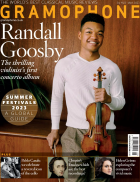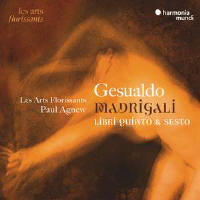Texte paru dans: / Appeared in: |
|
 |
Outil de traduction |
|
At the end of a multi-volume survey such as this, one inevitably reflects on the whole project as much as the final instalment, particularly since the first volume garnered a Gramophone Award in 2020 (not to mention rapturous reviews in these pages). But Gesualdo’s last two books of madrigals are a special case. To all intents and purposes a double album (published in the same year, 1611), they contain the madrigals that established the composer’s reputation in modern times. As such, they have been recorded and anthologised more often than the earlier books, and the competition is that much greater: Concerto Italiano (Naïve, A/00), Exaudi (Winter & Winter, A/19), La Venexiana and its successor, La Compagnia del Madrigale, have all committed formidable performances to disc, though only La Venexiana/Compagnia offer complete accounts of both books, let alone the complete cycle of madrigals, as Les Arts Florissants do under Paul Agnew. To be clear, there are gems in all of them: I was very impressed with La Compagnia’s Book 2 when it came out three years ago (Glossa, 1/20); certain things from Exaudi’s anthology stay in the memory (the stunning conclusion to ‘Asciugate i begli occhi’, for example); and Concerto Italiano’s
For these interpretations are all about risk. Les Arts Florissants take heed of Rinaldo Alessandrini’s attention to text (which is at all times admirably clear), but without atomising the musical narrative as he is fond of doing; they achieve admirable clarity of form and argument in nearly every case. The opening madrigals of their respective books are instructive, because they are affective mirror images of each other: ‘Gioite voi col canto’ begins genially enough but ends in despair, while nothing in the hallucinatory opening of ‘Se la mia morte brami’ (surely one of Gesualdo’s most desperate) presages the relative quietude of its conclusion. Alessandrini and others associate these extreme expressive juxtapositions with the composer’s attested sadomasochistic tastes, and although Gesualdo’s reception history is the classic illustration of the risks in reading the life in the work, many of his madrigals undeniably turn on such contrasts that there is surely some truth in it. (The setting of the word ‘dolore’ at the end of ‘Beltà, poiché t’assenti’ really does give the game away.) Pace Agnew’s repeatedly stated aim to redress the balance in favour of the work, the vitality of his interpretations underscores the tension between the two approaches.
Those insistent on an immaculate surface will almost certainly turn to the recordings mentioned earlier; in fairness, it seems to me that in this final set the French ensemble tremble more audibly on their tightrope, particularly in the rapid, imitative or staccato passagework that Edward Breen and I marvelled at in previous books (12/19, 4/21), when the whole ensemble turned on a dime (try the conclusion of ‘Tu piangi, o Fille mia’ or the opening phrase of ‘Ardita zanzaretta’, both very tricky to pull off, admittedly). And they’re certainly happy to court ugliness: ‘Beltà, poiché t’assenti’ threatens several times to tip over the edge, thrillingly. But when (as so often) the shaping and pacing of a madrigal are so finely judged (‘Felicissimo sonno’, ‘Occhi del mio cor vita’), a purple passage so poignantly delivered (‘Ahi, che pianger debb’io’ in ‘Asciugate i begli occhi’ or ‘e pietosa’ in ‘Felicissimo sonno’), one feels Gesualdo himself would have been … well, happy. EB emphasised just how subtle these performances are, and they fully reveal the subtlety of the music. To those for whom performances of early polyphonic repertoires can be too similar, the competing approaches of Les Arts Florissants and their Italian rivals offer hope of something better. If forced to choose between the two, I’d plump for the French, first because of their greater consistency, but most of all because their thrilling approach returns you to life more violently, as Francis Bacon (another sadomasochist of genius) memorably phrased it – surely the whole point of Gesualdo. But in the end (and pace this last point), Agnew is surely right to insist on the music’s ability to stand on its own terms. It bears repeating: those who have thought of Gesualdo as a one-trick pony (‘Moro lasso’ and all that …) now have more than six hours’ evidence to the contrary. What a composer. |
|




